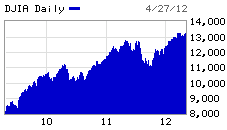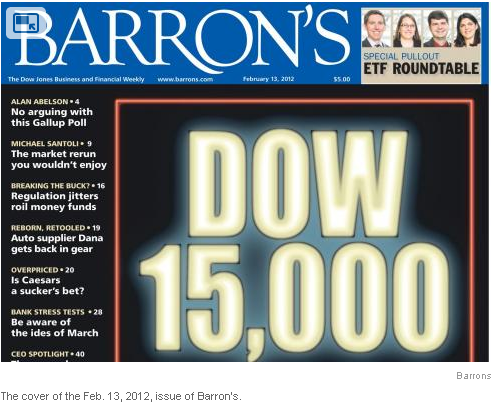Magazines' rosy outlooks often followed by market downturn
When United-ICAP analyst Walter Zimmermann set eyes on the big, boldface, tabloid-esque headline "DOW 15,000" on the Feb. 13 cover of Barron's, it was akin, he says, to a black cat crossing the path of stock investors.
The next day, he e-mailed a report to clients warning that the respected financial weekly's upbeat story - which laid out why the 3-year-old bull market had more room to run - might be signaling just the opposite. Citing history, he argued that the bullish message splashed on the cover of Barron's was a textbook contrarian signal showing that investor optimism was getting too euphoric. Zimmermann concluded that all the ingredients were in place for a "major, world-class top" in the stock market.
Bullish cover stories, Zimmermann's extensive research shows, are more akin to a Wall Street curse. A sign of coming bad luck. A warning flag.
Zimmermann bases his bearish reaction to the bullish story on what he dubs the "Cover Story Syndrome."
"History has shown," he says, "that by the time a financial trend has lasted long enough and been powerful enough to make it onto the front page of a magazine, that trend is typically ending, (is) already over or has already reversed direction."
Often, what has been flying the highest is also at risk of falling the hardest. The "cover curse" is not just tied to the stock market. Bullish cover stories related to oil, the U.S. dollar, gold, individual stocks, hot companies, superstar CEOs, even elite athletes, often portend topping action. The reason: Cover stories are always super-bullish at the top or at times of peak performance.
The Dow has doubled since its bear market bottom three years ago and would have to rise another 12.7% to reach 15,000. The night before the Barron's story touting Dow 15,000 hit newsstands, the Dow closed at 12,801. It's currently trading roughly 300 points higher at 13,091, after dipping as low as 12,716 in early April.
Outlier performances by stock indexes, companies and sports stars are hard to sustain, setting big winners up for a fall. All sublime performances are subject to "mean reversion": At some point, the outperformance ends, and more-average performance returns.
The risk for investors is that they may get overly confident after reading optimistic cover stories, let their guards down and dive into the stock market, even though the bulk of the big move up has already occurred, says Price Headley, chief investment strategist at BigTrends.com.
"Regular investors say to themselves, 'This is a great time to buy,' " says Headley.
Up from the bear market low, Dow Jones industrial average, 3 year chart.

A better time to buy, Headley says, is when there is "maximum pessimism and fear," and the media are running stories that warn of impending doom. The best example is the infamous BusinessWeek cover story, "The Death of Equities," that ran in its Aug. 13, 1979, issue. Stocks, of course, were about to start a two-decade bull run.
Bob Dickey, of RBC Wealth Management, noted in a report that stocks "voted most popular" by the press tend to be near the end of their rallies.
A Time magazine cover at the height of the Internet boom in December 1999 that named Amazon (AMZN) CEO Jeff Bezos as "Person of the Year" also marked the peak of Amazon's stock in that market cycle. The online retailer hit an intraday high of $113 in mid-December 1999, only to fall to a low of less than $6 a share in late September of 2001.
Omens and warnings?
History proves that nothing lasts forever, no matter how good the story seems at the time:
.Near the last stock market top in 2007, for example, a March 5 Fortune magazine cover story dubbed Stephen Schwarzman, CEO of private-equity firm Blackstone, "The New King Of Wall Street." Three months later, on June 25, Blackstone's (BX) stock peaked on the first day of its initial public offering. It closed that day at $32.44 and fell nearly 90% before bottoming at less than $4 a share in February 2009.
A similar fate has befallen football players selected for the box cover of the Madden NFL video games. It's called the "Madden Curse." Quarterbacks Michael Vick and Donovan McNabb both suffered injuries and missed time after appearing on the cover.
There's also the famous Sports Illustrated "cover jinx," in which athletes featured on the sports magazine's cover go on to experience bad luck. Race car driver Pat O'Connor was featured on the cover of SI's 1958 Indianapolis 500 preview. He was killed in a 15-car pileup during the race's first lap. In 2002, SI did an analysis of the "cover jinx" and found that nearly 40% of its cover subjects suffered a major misfortune or decline in performance after they graced the cover.
A trending buzz
Cover stories that make major market calls are rare, as they occur only after editors deem it the story with the most buzz after sifting through any number of hot topics trending among the masses. These stories, which tout coming booms or busts, also tend to be reliable contrarian indicators. In other words, by the time a story such as Dow 15,000 attains cover status, it's usually a sign that most of the good news is already priced into the market and that the investing herd is all leaning dangerously in the same direction.
"Readers want to read about the latest, greatest thing," explains Zimmermann. "What's booming. What's going up. What company or person is shining the brightest. But by the time it makes it to the cover of a magazine, the trend has been on an ascent for a long time. Nothing goes up forever."
A BigTrends.com analysis of bullish and bearish cover stories in the past three decades found that the stock market moved in the opposite direction of the article's call more than 70% of the time. A big reason stocks tend to slump after major bullish stories is that media coverage raises expectations too high.
"Think of it like raising the bar higher and higher for a high jumper," says Headley. "Each time you raise it, it increases the risk of disappointment."
Just when investors might benefit from a story warning of the potential risks ahead, the news tends to follow the trend and point out all the reasons stocks have been going up, which could cause investors to jump in at the wrong time.
Collating the signs
Wall Street has long sought to identify contrarian signals. Magazine cover stories are just one tool. Investors measure bullish and bearish sentiment by tracking weekly polls of individual investors, financial newsletter writers and investment advisers. In general, when the polls get overly bullish or bearish, analysts alert investors to the possibility that the market's price action will move in the opposite direction.
The most recent poll of members of the American Association of Individual Investors shows that only 31.2% are bullish, which is below the 39% long-term average and the 38% of bulls at the market peak in April 2011. Still, the level of bullishness is far from excessive, as it's way below the level of around 60% bulls that marked tops in 2000 and 2007. But another sentiment poll tracked by Zimmermann is nearly as bullish as it was near the peaks in 2007 and 2000.
Right now, even though the Barron's story sent a super-positive message, other sentiment indicators suggest that optimism is far from extreme, which bodes well for stocks, counters Carmine Grigoli, chief investment strategist at Mizuho Securities USA.
"Some key elements that point to excessive optimism are missing," says Grigoli. "What is missing are excessive valuations, extensive involvement in the stock market by individual investors and excessive speculation. While there is some bullishness out there, there is not enough to say, 'This is the time to check out of stocks.' "
Retail investors have yanked money out of U.S. stock funds nine consecutive weeks, says the Investment Company Institute, a mutual fund trade group. And the broad market is trading at 13 times projected 2012 earnings, below the average price-to-earnings ratio of 15, says S&P Capital IQ.
The usefulness of the Cover Story Syndrome as a market-timing tool is most accurate when it's evaluated in the context of all the current business conditions driving stock prices, says Chris Johnson, director of research at JK Investment Group.
"You don't want to call it an indicator on its own," he says. Currently, given the improving economy, positive price action of the Dow, and the fact that retail investors are still skittish and yanking money out of stock mutual funds and pouring it into bond funds, suggests that Barron's Dow 15,000 cover may be a realistic price target.
"The Dow 15,000 cover makes a little bit of sense," Johnson says. The market's upturn, he adds, is far from the final stage of a bull market, what he dubs the "euphoria stage." If it were, investors would be "all in," and dumping their bond funds to buy stocks.
Courtesy of Adam Shell, USA TODAY

